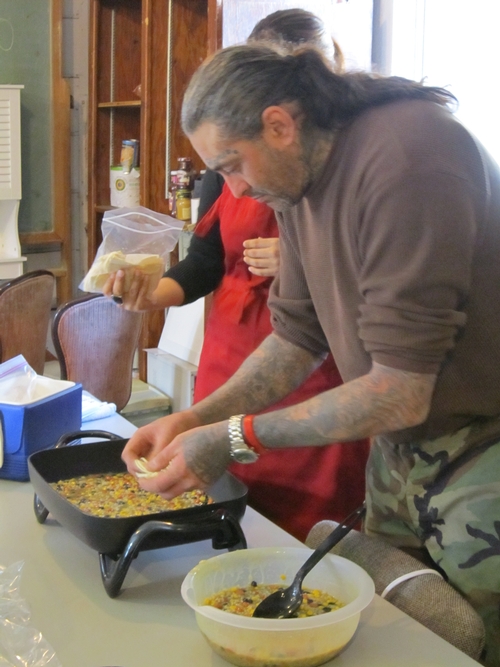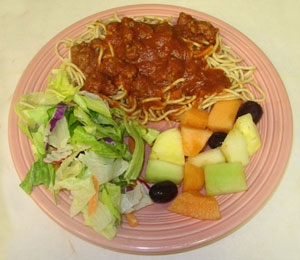Posts Tagged: Connie Schneider
National Nutrition Month®
March is National Nutrition Month®! Thirty-eight years ago a week long campaign to promote nutrition was launched by the American Dietetic Association. That same campaign gained public popularity and has since expanded to what is now known as National Nutrition Month®. This March the theme is “Eat Right with Color.” The American Dietetic Association (ADA) recommends:
Start with the basics. Use MyPyramid to build a healthy, balanced diet. Visit www.mypyramid.gov for your personalized food plan.
Nutrient-dense foods. The ADA also suggests focusing foods that are rich in vitamins and minerals and lower in calories and fat. For example, whole grain toast with low-fat cheese, fruit, and a cup of coffee with low-fat milk will provide more nutrients than a muffin and a coffee drink filled with sugared syrup and whipped cream. Try the yummy National Nutrition Month recipes, which will satisfy your taste buds and your body’s craving for nutrients!
Variety is important. Varying the foods you consume will ensure you are getting all the nutrients that your body needs. Aim to build a rainbow on
your plate!
Make the most of family meal-time. The eating habits children learn today are the habits they will have tomorrow. Model healthy eating habits with children to help them make healthy choices.
Physical activity is important for “managing weight and overall health.” MyPyramid encourages at least 30 minutes per day.
These five key messages are at the core of all the events taking place during National Nutrition Month®. Activities in different venues are put on by the ADA to spread nutrition awareness. In schools and at community centers there are activities and/or events taking place to celebrate National Nutrition Month®. For more information about events or activities or information in about National Nutrition Month®, click here.
Blog contributors: Connie Schneider, Ph.D., R.D., Kathleen Burke, CSUF Dietetic Intern, & Shelby MacNab, Nutrition Program Manager
National Nutrition Month 2011 Recipes

salad
EFNEP helps us eat well on the cheap
Last week (Jan. 31, 2011) the U.S. Department of Agriculture released its revised 2010 Dietary Guidelines for Americans. They are “the federal government's evidence-based nutritional guidance to promote health, reduce the risk of chronic diseases, and reduce the prevalence of overweight and obesity through improved nutrition and physical activity,” according to the press release.
I scanned the press release for news that cookies have been designated an essential food group. No luck. I confess, I didn’t read the entire 95-page pdf, but surely any such rocking revelations would have been reported in the press release.
Because more than one-third of children and more than two-thirds of adults in the United States are overweight or obese, the guidelines emphasize eating less and moving more.
I wasn’t surprised to see among its 23 key recommendations the advice to drink more water instead of sugary drinks, eat a variety of healthy foods and reduce salt. I expected the recommendation to eat more fruits and vegetables, but now it’s more explicit.
They say half of my plate should be covered in fruits and veggies. And mix it up – eat a variety of vegetables and protein sources. (I used to eat broccoli beef almost every day for lunch, until the day I found an insect in it.)
Many people think they have to spend more for nutritious meals, that fresh produce and meat are expensive. However, UC’s Expanded Food and Nutrition Education Program, or EFNEP, gives tips on how to make healthful food choices when you’re on a limited income. (Unless your name is Mark Zuckerberg, whose income isn’t limited?)
Chapter 6 of the Dietary Guidelines acknowledges that our environment – composed of school, workplace, social groups, culture and so on – influences our food and exercise choices. However, our communities don’t excuse our behavior because ultimately we make our own choices, it essentially says. We may have more access to healthy foods and opportunities to engage in physical activity than we realize. Connie Schneider, EFNEP Council chair, sees EFNEP as a vehicle to help families navigate their complicated food environments.
“Our educators facilitate group discussions to resolve food issues from shopping on a budget to getting their children to eat healthier foods,” said Schneider, who is also a UC Cooperative Extension nutrition advisor.
The EFNEP staff meets with families and children in a variety of community settings, including schools, shelters and transitional housing. Nutrition educators teach them how they can stretch their food dollars and still enjoy a healthy diet. They share recipes for nutritious meals that are simple to prepare as well as inexpensive. I love to eat, but have little patience for cooking. Watching a nutrition educator demonstrate how to make chili, I found myself thinking, “That’s so quick and easy, even I would do that.”
Sometimes a new way of preparing a familiar vegetable encourages me to eat more veggies.
The EFNEP website spotlights a Fresh Pick of the Month, such as cauliflower. The site gives the nutritional benefits of cauliflower, serving tips and recommendations for handling and storing the vegetable. It also provides a recipe for cauliflower soup.
The nutrition educators also publish monthly newsletters, in English and Spanish, featuring a recipe and healthful suggestions, such as walking to the restaurant and sharing entrees when you go out to eat. Although the nutrition program is designed to assist families and children whose resources are limited, we can all use the suggestions to improve our health and save some money.

EFNEP enchilada casserole preparation
A new approach in teaching healthy eating
UC Cooperative Extension nutrition educators have discovered that, when it comes to teaching consumers how to eat right, a picture is worth of thousand words.
“We’ve been teaching people for years about MyPyramid and the dietary guidelines, serving sizes and the number of servings they should eat, but many were having a hard time translating that to what exactly to put on their plates,” said Cathi Lamp, the nutrition, family and consumer sciences advisor for Tulare County UCCE.
In an effort to simplify nutrition education, UCCE started with a graphic of a plate, with half designated for fruits and vegetables and a quarter each for protein and grains. However, the concept was still too abstract for concrete thinkers.
“Then we hit upon the idea of photographing familiar foods in the right proportions and showing actual serving sizes arranged on a plate,” Lamp said.
Lamp, and the nutrition, family and consumer sciences advisors for Fresno County, Connie Schneider, and Kern County, Margaret Johns, set out to review 24-hour recall surveys that had been conducted by participants in UCCE nutrition education classes. The 24-hour recall surveys, a mainstay in nutrition research, ask participants to write down everything they have eaten in the previous 24 hours. Each of the advisors focused on recalls from target population groups – Latinos, African-Americans and the general population.
Once they knew what foods people eat, Lamp, Schneider and Johns began the labor-intensive process of preparing and photographing test pictures showing healthy food combinations. Meals included chicken, pizza, spaghetti, sandwiches, tacos, pork chops, fish, stir fry, hamburger, soup and eggs.
Eighteen plates of food were photographed for initial, informal testing. Lamp took the photos to an education session at the local WIC office, where pregnant women and new mothers receive federal nutrition support.
“We handed out a little form and asked the moms if they could identify the foods, whether these were foods they would eat and, if not, what changes they would make,” Lamp said. “The WIC educators loved the images. They could see the value of images of healthy food right off the bat.”
The next step will be cognitive testing of the photos with target clientele, adjustment of the photos based on the results of the testing, retesting the photos in a nutrition education setting and analyzing the results.
Cathi Lamp explains food plate design process.



